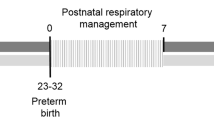Abstract
Objective
Tracheobronchomalacia (TBM) is common in neonates with bronchopulmonary dysplasia (BPD) and is associated with higher morbidity. This study evaluates the value of a CT protocol to assess the degree of TBM and gauge the adequacy of prescribed PEEP.
Study Design
Four infants with severe BPD on invasive mechanical ventilation underwent a chest CT protocol, including limited reduced-dose expiratory scans with varying PEEP levels.
Results
Baseline PEEP was adjusted in all subjects after performing the Dynamic PEEP CT. In two infants, the PEEP was increased due to significant TBM and in the other two without signs of TBM PEEP was decreased. The clinical course improved in all patients after adjusting PEEP.
Conclusion
A “Dynamic PEEP” study may be reliable and non-invasive imaging modality for the evaluation of adequate ventilator settings in infants with severe BPD who are not optimal candidates for bronchoscopy.


Similar content being viewed by others
Abbreviations
- BPD:
-
Bronchopulmonary dysplasia
- PEEP:
-
Positive end-expiratory pressure
- FRC:
-
Functional residual capacity
- NICU:
-
Neonatal intensive care unit
References
Thébaud B, Goss KN, Laughon M, Whitsett JA, Abman SH, Steinhorn RH, Aschner JL, Davis PG, McGrath-Morrow SA, Soll RF, Jobe AH (2019) Bronchopulmonary dysplasia. Nat Rev Dis Primers 5(1):78. https://doi.org/10.1038/s41572-019-0127-7
Amin RS, Rutter MJ (2015) Airway disease and management in bronchopulmonary dysplasia. Clin Perinatol. https://doi.org/10.1016/j.clp.2015.08.011
Miller RW, Woo P, Kellman RK, Slagle TS (1987) Tracheobronchial abnormalities in infants with bronchopulmonary dysplasia. J Pediatr. https://doi.org/10.1016/S0022-3476(87)80267-6
Downing GJ, Kilbride HW (1995) Evaluation of airway complications in high-risk preterm infants: application of flexible fiberoptic airway endoscopy. Pediatrics. https://doi.org/10.1542/peds.95.4.567
Austin J, Ali T (2003) Tracheomalacia and bronchomalacia in children: pathophysiology, assessment, treatment and anaesthesia management. Paediatr Anaesth 13(1):3–11. https://doi.org/10.1046/j.1460-9592.2003.00802.x
Hysinger EB, Friedman NL, Padula MA et al (2017) Tracheobronchomalacia is associated with increased morbidity in bronchopulmonary dysplasia. Ann Am Thorac Soc. https://doi.org/10.1513/AnnalsATS.201702-178OC
Hysinger E, Friedman N, Jensen E, Zhang H, Piccione J (2019) Bronchoscopy in neonates with severe bronchopulmonary dysplasia in the NICU. J Perinatol 39(2):263–268. https://doi.org/10.1038/s41372-018-0280-y
Blanch L, Francesca Bernabé UL (2005) Measurement of air trapping, intrinsic positive end-expiratory pressure, and dynamic hyperinflation in mechanically ventilated patients. In: Respiratory Care.
Kinsella JP, Greenough A, Abman SH (2006) Bronchopulmonary dysplasia. Lancet. https://doi.org/10.1016/S0140-6736(06)68615-7
Swier NL, Richards B, Cua CL et al (2016) Pulmonary vein stenosis in neonates with severe bronchopulmonary dysplasia. Am J Perinatol. https://doi.org/10.1055/s-0035-1571201
Goo HW (2013) Free-breathing cine CT for the diagnosis of tracheomalacia in young children. Pediatr Radiol. https://doi.org/10.1007/s00247-013-2637-x
Ullmann N, Secinaro A, Menchini L et al (2018) Dynamic expiratory CT: an effective non-invasive diagnostic exam for fragile children with suspected tracheo-bronchomalacia. Pediatr Pulmonol. https://doi.org/10.1002/ppul.23831
Mackanjee HR, Naidoo L, Ramkaran P, Sartorius B, Chuturgoon AA (2019) Neonatal bronchoscopy: role in respiratory disease of the newborn-a 7 year experience. Pediatr Pulmonol 54(4):415–420. https://doi.org/10.1002/ppul.24243
Ngerncham M, Lee EY, Zurakowski D, Tracy DA, Jennings R (2015) Tracheobronchomalacia in pediatric patients with esophageal atresia: comparison of diagnostic laryngoscopy/bronchoscopy and dynamic airway multidetector computed tomography. J Pediatr Surg 50(3):402–407. https://doi.org/10.1016/j.jpedsurg.2014.08.021
May LA, Jadhav SP, Guillerman RP, Ketwaroo PD, Masand P, Carbajal MM, Krishnamurthy R (2019) A novel approach using volumetric dynamic airway computed tomography to determine positive end-expiratory pressure (PEEP) settings to maintain airway patency in ventilated infants with bronchopulmonary dysplasia. Pediatr Radiol 49(10):1276–1284. https://doi.org/10.1007/s00247-019-04465-7
Lee EY, Strauss KJ, Tracy DA, d’Almeida Bastos M, Zurakowski D, Boiselle PM (2010) Comparison of standard-dose and reduced-dose expiratory MDCT techniques for assessment of tracheomalacia in children. Acad Radiol 17(4):504–510. https://doi.org/10.1016/j.acra.2009.11.014
Del Cerro MJ, Rotés A, Cartón A, Deiros L, Bret M, Cordeiro M, Verdú C, Barrios MI, Albajara L, Gutierrez-Larraya F (2014) Pulmonary hypertension in bronchopulmonary dysplasia: clinical findings, cardiovascular anomalies and outcomes. Pediatr Pulmonol 49(1):49–59. https://doi.org/10.1002/ppul.22797
Hysinger EB, Bates AJ, Higano NS, Benscoter D, Fleck RJ, Hart CK, Burg G, De Alarcon G, Kingma PS, Woods JS (2020) Ultrashort echo-time MRI for the assessment of tracheomalacia in neonates. Chest 157(3):595–602. https://doi.org/10.1016/j.chest.2019.11.034
Higgins RD, Jobe AH, Koso-Thomas M, Bancalari E, Viscardi RM, Hartert TV, Ryan RM, Kallapur SG, Steinhorn RH, Konduri GG, Davis SD, Thebaud B, Clyman RI, Collaco JM, Martin CR, Woods JC, Finer NN, Raju TNK (2018) Bronchopulmonary dysplasia: executive summary of a workshop. J Pediatr 197:300–308. https://doi.org/10.1016/j.jpeds.2018.01.043
J. Boone, K. Strauss, D. Cody, C. McCollough, M. McNitt-Gray, and T. Toth (2011) “Size-specific dose estimates (SSDE) in pediatric and adult body CT exams,” Report of AAPM task group 204.
Author information
Authors and Affiliations
Contributions
CS, RS, JB, HH, MS, and GFP contributed to the design and implementation of the research, to the analysis of the results, and to the writing of the manuscript.
Corresponding author
Ethics declarations
Conflict of interest
The authors declare that the research was conducted in the absence of any commercial or financial relationships that could be construed as a potential conflict of interest.
Additional information
Publisher's Note
Springer Nature remains neutral with regard to jurisdictional claims in published maps and institutional affiliations.
Rights and permissions
About this article
Cite this article
Montoya, C., Steinhorn, R., Berger, J. et al. Dynamic PEEP Study: A Non-invasive Diagnostic Exam to Assess for Effective PEEP in Children with Severe BPD. Lung 200, 59–65 (2022). https://doi.org/10.1007/s00408-021-00497-9
Received:
Accepted:
Published:
Issue Date:
DOI: https://doi.org/10.1007/s00408-021-00497-9




